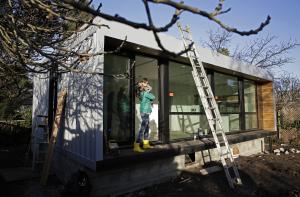Small homes play big role in cities’ fight for affordable housing

Encouraging construction of small backyard homes like this one in Menlo Park, Calif., is one strategy cities are using to overcome housing shortages. (Michael Macor/San Francisco Chronicle via AP)
As a housing affordability crisis grips more and more U.S. metros, city leaders are embracing the idea that they need to enable more housing to be built in their communities. And for good reason: Estimates of the national housing supply shortage range from 3.8 million housing units to 6.8 million.
An innovation a growing number of cities are turning to is to encourage homeowners to build small backyard homes or convert garages into living space. These accessory dwelling units, also known as casitas or “granny flats,” are typically 600 to 1,000 square feet in size, and help add more housing into built-out neighborhoods without dramatically changing their character.
Ten states and the District of Columbia, as well as more than a dozen cities, have passed or revised laws enabling the use of accessory dwelling units—or ADUs—through zoning, parking, or land-use changes. Freddie Mac, the federally chartered housing finance company, estimated in 2020 that the United States had 1.4 million legal ADUs, half of them in California, Florida, Texas, and Georgia. In California alone, permits associated with ADU construction rose to nearly 20,000 in 2021 from about 1,200 in 2016.
“More and more places are really starting to see what's happening in terms of the needs of their communities not being met in the affordable housing crisis,” says Rodney Harrell, a vice president at AARP, which promotes ADUs as a flexible housing option for seniors and for people of all ages. “ADUs become a great way to try to make up for lost time and not having enough options in communities.”
The rising popularity of ADUs is due in no small part to pioneering work done by the Los Angeles innovation team beginning in 2015. That’s when then-Mayor Eric Garcetti asked his i-team to find ways to increase housing supply quickly, using the levers the city had at its disposal.
At the top of the team’s list of findings was the vast potential of ADUs. But Amanda Daflos, who headed the i-team then and now leads the Bloomberg Center for Public Innovation at Johns Hopkins University, says they also found that ADUs were a hot-button political issue. “There were a lot of myths, a lot of battles, and a lot of history,” she says. “No one had ever successfully taken this on.”
Daflos and team were undeterred and quickly found that one of the most potent myths about ADUs was that there already were huge numbers of them in Los Angeles. (It turned out there were only about 400, in a city of almost 4 million.) Another obstacle was the popular belief that ADUs could only be built illegally, without proper permits, and were therefore dangerous to live in.
The team set out to make the process for legally constructing an ADU as simple and transparent as possible. As a pilot, they partnered with a homeowner to build an ADU. That helped them identify bureaucratic barriers the city could remove, and begin to change the narrative about ADUs as press coverage showed the public how attractive a small home could be.
The city also updated its codes to encourage ADU construction and set up a special service counter for ADU permitting. The response was staggering: According to an analysis of California state data in The Atlantic, Los Angeles saw the number of ADU permits issued jump from 80 in 2016 to 5,064 in 2021—a more than 6,000-percent increase—and the small homes account for about one in four new units built. ADUs haven’t solved L.A.'s affordable housing crisis, but they’re helping in a big way.
“We created a market,” Daflos says. “Homeowners could do it. And we were making it easier for that to happen.” L.A.’s work informed statewide policy changes in California that helped ignite an ADU building boom in cities across the state.
Over the past two years alone, at least 17 other cities, including Denver, Louisville, Ky., and Kansas City, Mo., have passed legislation to ease construction of ADUs. (AARP's model ADU bill, which also informed efforts in California, is an easy starting place for any city or state.) In San Antonio, city officials recently updated the development code to make it faster and easier for residents to build ADUs, and are using their participation in the Bloomberg Philanthropies City Data Alliance to ensure they collect the right data to ensure that the changes are working.
“Accessory dwelling units represent an important tool for relieving the pressure on housing costs in San Antonio,” San Antonio Mayor Ron Nirenberg tells Bloomberg Cities. “I’ve worked to remove regulatory barriers to ADU development in San Antonio to facilitate new ADU construction to add to our local housing supply, facilitate multigenerational living, and provide opportunities to build generational wealth.”
And the groundbreaking ADU work continues in Los Angeles under the i-team’s direction through the continuing development of the L.A. ADU Accelerator Program, a 2018 Bloomberg Philanthropies U.S. Mayors Challenge winner. The program pairs older adults with homeowners willing to provide a stable home by offering their ADUs as rentals. In exchange, homeowners receive benefits such as qualified tenant referrals, tenant case management, and stable rental payments.
Accelerator Program Director Becky Gross says that while the program remains in a pilot phase, the city has partnered with 25 homeowners and housed 32 older adults. A crucial part of the program’s design is to use ADUs “as a bridge housing program for low-income older adults to prevent them from becoming homeless,” Gross says. The Accelerator is currently on track to move about seven ADU tenants to permanent housing by late summer.
One of the largest remaining stumbling blocks for scaling up ADU construction in Los Angeles and in cities across the nation is a lack of financing. “From my experience and my research, banks and other lending institutions are hesitant to lend to ADU constructions just because it’s a newer housing model,” Gross says. “It's a newer financial model. They don't quite grasp the concept.”
The AARP’s Harrell agrees. During a White House webinar on ADUs last year, problems with financing kept coming up. “There just aren't enough financing models out there that can take into account the benefits to the homeowner to build an ADU, and thereby providing them with the products that can help them build these things easily,” Harrell says.
Daflos says she hopes to capture more of the lessons learned from Los Angeles’ ADU work, as she continues to hear from other cities who are anxious for advice. “L.A. was definitely a pioneer here,” she says. “And other cities can learn about the policy, they can learn about the process, the literal things we did in planning to change it in terms of the experience for users so that they may advance the work and apply it to their own city setting and context.”
For cities facing an affordable housing crunch as well as a growing senior population, ADUs are something of a “Swiss Army knife solution,” Harrell says. “It may not completely address any one issue, but it provides more options in those communities where people want to be. It’s a good way to create more housing options that can meet a wider range of needs.”


